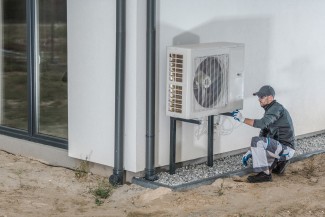As states work to implement their rebate programs under the Inflation Reduction Act, coordination with existing utility-funded energy efficiency programs is vital to ensure the greatest energy and utility bill savings for the long term.
States have begun to roll out Home Energy Rebates for efficiency and electrification improvements, a key measure under the 2022 Inflation Reduction Act. The $8.8 billion program will benefit a meaningful number of households, but its impact can go far beyond the initial federal investment if it is strategically administered so that it spurs future progress.
Read the Topic Brief The Department of Energy estimates that rebate programs will save households up to $1 billion annually on energy bills and support over 50,000 U.S. jobs. In a new topic brief today, we outline how pairing the rebates with utility efficiency efforts and growing the utility programs for the long term could result in cost savings and job creation far beyond what the federal rebates can achieve.
Federal rebates are an opportunity for states to coordinate with utility efficiency programs of all sizes
Investments in energy efficiency by utility programs vary widely across the states. ACEEE analyzed utility efficiency investments and federal rebate funding for states, comparing utility investments from 2019 to 2023 to each state’s allocations under the federal Home Energy Rebates. As can be seen below, utility spending ranges from nearly nine times the federal rebates to less than one penny for each federal rebate dollar. But the 49 states, DC, and territories applying for rebate funding all will benefit from coordinating with utilities, which can limit duplication while expanding the reach of the programs.
Utility-funded efficiency program investments from 2019 to 2023 per $1 of five-year Inflation Reduction Act rebate funding for each state. South Dakota (in red) opted not to accept the rebate funding.
In states where utility efficiency investments are small, coordination on the rebates can help utility and state programs ramp up energy efficiency services for residents so they are more robust and can continue to serve more households. Stronger programs for the long-term can result in significant energy savings, reducing utility bills and cutting pollution for decades to come.
In states where utility efficiency investments are far larger than the federal incentives, coordination can offer residents additional benefits that the utility programs alone do not offer. For example, the federal rebates cover the cost of electrical panel and wiring upgrades, which may be needed for electrification upgrades, like heat pumps, but usually fall outside the scope of ratepayer-funded efficiency programs. By coordinating program offerings, states and utilities can make it easier for residents to participate and ensure they are getting all of the incentives they are eligible to receive.
Coordination could also help spur long-term improvements in apartment buildings, which utility efficiency programs have traditionally underserved. Because of federal requirements setting aside a portion of the rebate funding for apartment buildings, many state rebate programs have a major focus on these buildings. Utilities have the opportunity to coordinate with programs serving apartment buildings and in the long term add these programs to their portfolios as the federal programs wind down.
Utility programs can complement rebate-funded efficiency measures
The federal rebates do not cover the full cost of many efficiency upgrades. For example, the $8,000 available for heat pumps will not cover the full cost of buying and installing a heat pump in many homes. But pairing these rebates with existing utility incentives for heat pumps will further reduce costs and make it easier for families to save energy and cut monthly utility bills.
ACEEE’s new brief outlines how well-coordinated programs can expand the set of efficiency measures they offer, increase the savings per project, and increase the number of households served. It also includes case studies on Inflation Reduction Act–funded state programs launched just in the last several months that have simplified requirements, targeted housing types underserved by existing utility programs, and provided low-interest financing to complement utility and federal incentives.
The brief released today is the first in a series of three. The second will outline how utility regulators can help enable coordination between utility programs and state energy offices. The third will review how successful coordination in the near term can help develop business models that work for contractors and customers and increase demand for energy efficiency and electrification upgrades. Together these efforts can ensure a long-term transition to well-insulated homes with efficient appliances, cutting household costs and reducing pollution for decades ahead.



